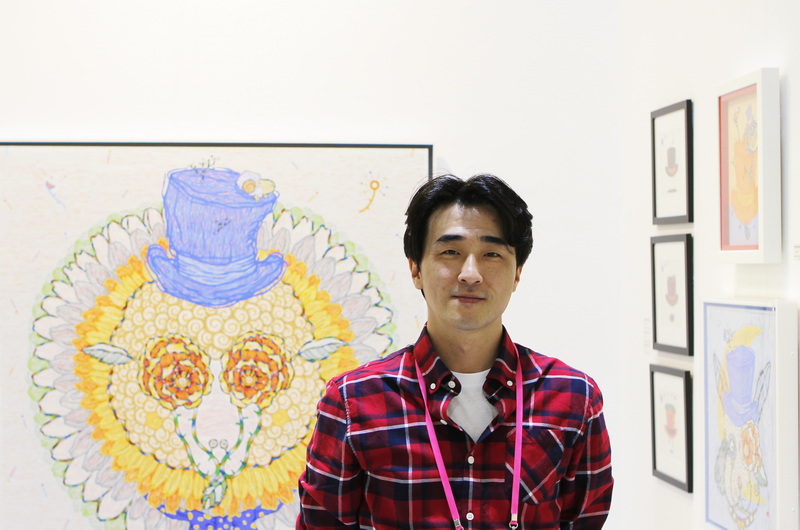Painting the Co-existence of Contradictions: Interview with Lee Doohwan
By Kang Jennis Hyunsuk
“How are Korean paintings different from Western paintings?” Have you ever given this a thought? Well, Korean paintings can be divided into three traditional types: sumuk-hwa (수묵화, ink paintings), sumuk-damchae-hwa (수묵담채화, lightly colored ink paintings), and chaesaek-hwa (채색화, traditionally colored paintings). In the olden days, neo-Confucian scholars, called seonbi (선비), considered the four noble plants to have the virtues that scholars should pursue. So, they would paint cherry blossoms, orchids, chrysanthemums, and bamboo, (mae-nan-guk-juk, 매난국죽) in ink; this is sumuk-hwa. Sumuk-damchae-hwa is simply adding light colors to ink paintings, and chaesaek-hwa is painting with thick, bright colors. This last type of painting was used in Joseon Dynasty times mostly for royal court paintings and portraits by professional artists rather than a painting style for seonbi. Chaesaek-hwa is also the type of painting that has strongly influenced the modern-day paintings of Lee Doohwan. I recently had the opportunity to sit down and talk with artist Lee. This month, I share with you the contents of that interview with Lee, who asks us through his art, “How are you living in this modern society?”
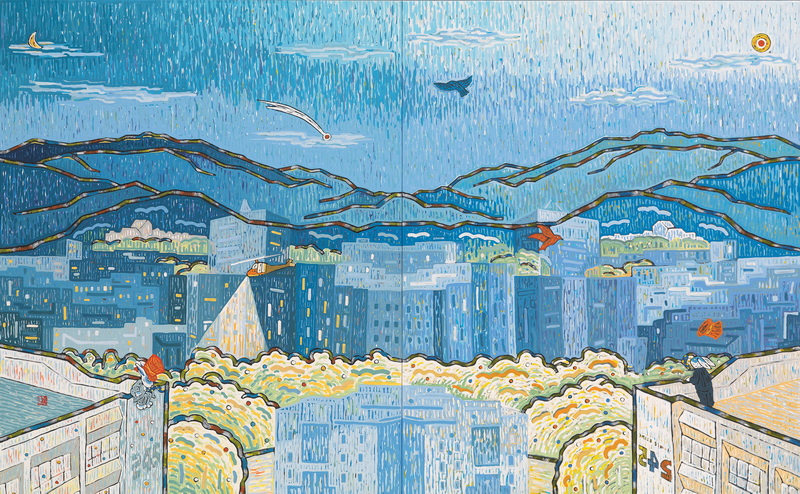
Jennis: Thank you for your precious time. Looking at your artworks in your studio, it is not easy to distinguish whether they are Western paintings or Korean paintings.
Lee Doohwan: Not many people can tell. I think the classifying of paintings has been created for the convenience of critics, though. I majored in Korean painting. Specifically chaesaek-hwa, traditional colored painting.
Jennis: I am curious about the painting process for chaesaek-hwa.
Lee Doohwan: In order to paint chaesaek-hwa, I should first make a foundation, like the canvas of Western painting. Chaesaek-hwa is painted on traditional Korean paper, hanji (한지). Hanji is made of the complex fibers of mulberry, so the paper has many natural holes. To make it strong, I layer several papers together by applying gelatin glue. This thick paper is called jangji (장지). Jangji is also a standard type of paper. It absorbs quite a lot of paint, so I coat the jangji with gelatin glue.
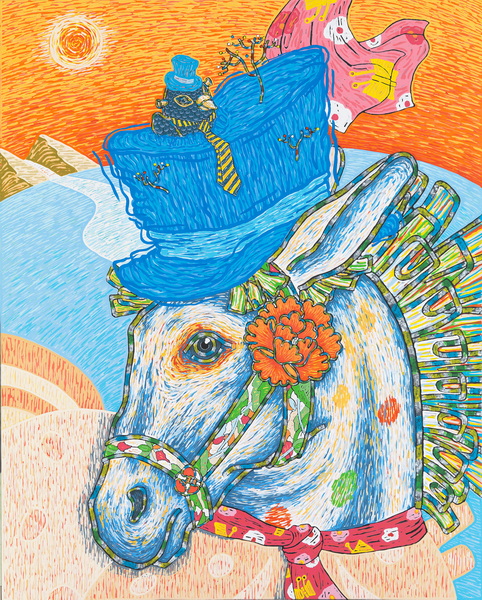
by Lee Doohwan, 2019.
Jennis: In Western painting, a surface treatment called gesso is applied to the canvas before painting to help express the colors well. In Korean traditional color painting, the gelatin glue coating plays the role of gesso, right?
Lee Doohwan: That is right. If the gelatin glue is mixed with alumn (명반) and is applied as a coating to the jangji paper, the degree to which the paint permeates lessens. The number of times the gelatin glue coating is applied creates diverse tones in chaesaek-hwa. If the glue coating were applied a dozen times, the jangji would become shiny like glass, and the paint would not permeate the base paper at all. Then the uniqueness of Korean painting would disappear.
There is another role of the gelatin glue in chaesaek-hwa. Most often, traditional Korean paints are extracted from the minerals of diverse stones. Another role of gelatin glue is making fine mineral powder into paint colors. When the gelatin glue is double-boiled, it melts into watery gelatin. The mixture of the watery gelatin and mineral powder makes paints.
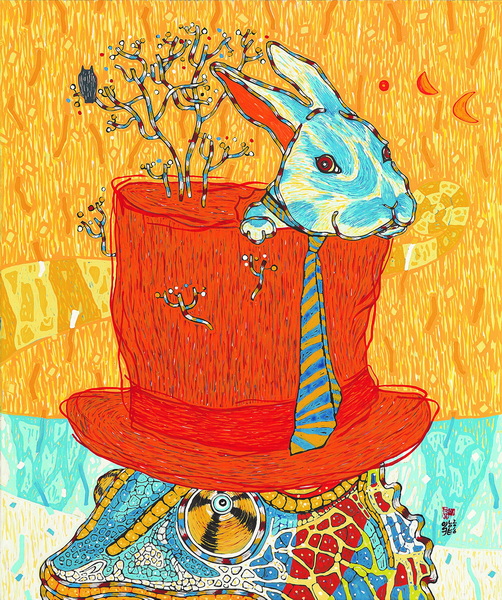
Jennis: Thank you, I have learned a lot about chaesaek-hwa coloring techniques. Now, I would like to ask you why you chose Korean painting for your style.
Lee Doohwan: As is true of most artists, I liked to draw when I was young. When I drew cartoon characters, my classmates asked me to sell them my drawings. Perhaps, I have wanted a job related to painting since then. Along the way, a friend of mine told me that I should go to an art academy to prepare for majoring in art when it was time to enter college. My parents opposed my entering art college because they thought it cost a lot and that an artist’s future was uncertain. But I persuaded them and started studying painting at an after-school academy. One day, I observed my academy teacher painting. He had majored in Korean painting, and he painted with only one brush. Putting several different colors on his brush, he painted without stopping. Amazingly, colorful flowers appeared from that single brush as it navigated the paper. I was fascinated by Korean painting from that time on, and that is why I majored in Korean painting.
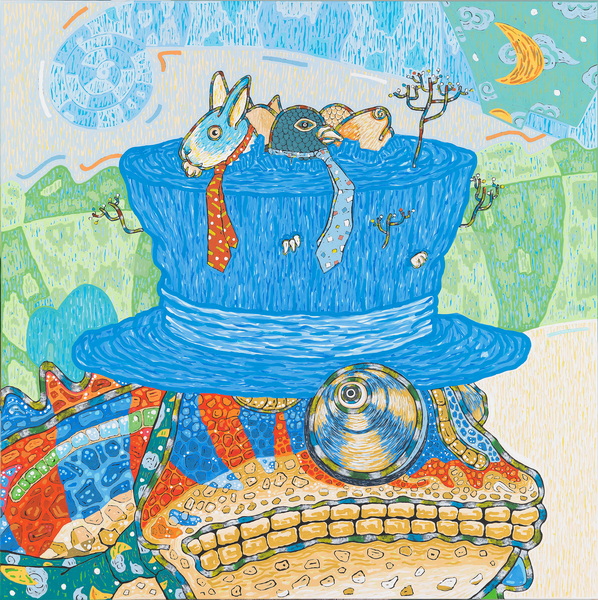
Jennis: Your profile says that your hometown is Incheon. I wonder how you decided to come to Gwangju to major in art at Chonnam National University.
Lee Doohwan: My older brother was an officer at that time, assigned to an army unit in Gwangju. The art college I had in mind was in Seoul, but my brother recommended that I apply to the College of Art at Chonnam University. Luckily, I was accepted to both art colleges at the same time. But the tuition of the art college in Seoul was expensive for me. My parents, who had six children, therefore, recommended that I go to Chonnam University. Thanks to receiving a scholarship for a year, I decided to take time to think about my future for a couple of semesters. As I moved to Gwangju, my brother was assigned to another area. Suddenly, I was left alone in the world with no one to share my past with.

Jennis: So, you have been living in Gwangju since then. How was life in an unfamiliar city?
Lee Doohwan: Being introverted, it was not easy for me to adapt to unfamiliar spaces. I think the overall theme of my art was created in those days. I started to express my thoughts and feelings in paintings while observing my strange surroundings. And I have been living and observing in Gwangju for 25 years now.
Jennis: Wow! So now, you have been residing in Gwangju longer than you have lived in your hometown of Incheon. I want to next ask you what the theme of your art is.
Lee Doohwan: The theme of my paintings is the inner portrait of human beings. When I entered the art college, I drew some characters with ink. In particular, I drew my self-portrait in a gloomy-looking way. At the time, I sat on the fence, thinking about whether to stay here or leave. Living an isolated life with little interaction with others, I painted dark self-portraits of me trapped in loneliness.
Then, I turned to observe the people around me for the purpose of looking inside myself. Doing so, I noticed a lot of things that I had not observed before. The process of observing and painting the people around me helped me to understand them. When I found a close resemblance with someone else or others, I felt that we were sharing the inner world of humans living in the contemporary era.
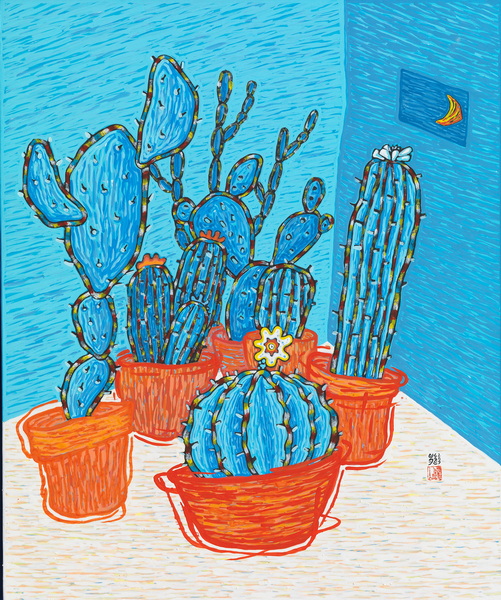
Jennis: You said that you had painted a lot of self-portraits with ink. From when did you start your painting in colors – when did you start painting chaesaek-hwa?
Lee Doohwan: As I got to know the world and experienced the absurd reality of society directly or indirectly, I painted portraits of depressed people in modern society. I had no choice but to make such paintings, even though I knew they would not be something that I could sell. Then one day, I read the contorted writing in the guest book at an exhibition. The writing looked like that of a child. It said, “Lee Doohwan’s paintings are so scary. I hope you paint pretty ones next time.” The words of the child were shocking. I pondered whether a painting that only the artist himself was satisfied with could be a “good” painting. I could not work for a while. Then, although I kept the same topic of examining modern people, I tried to reverse the expression. I tried to solve the problem that the child had pointed out with a twist: brightness – a 180-degree turnaround. That is why I started adding bright colors to my paintings.
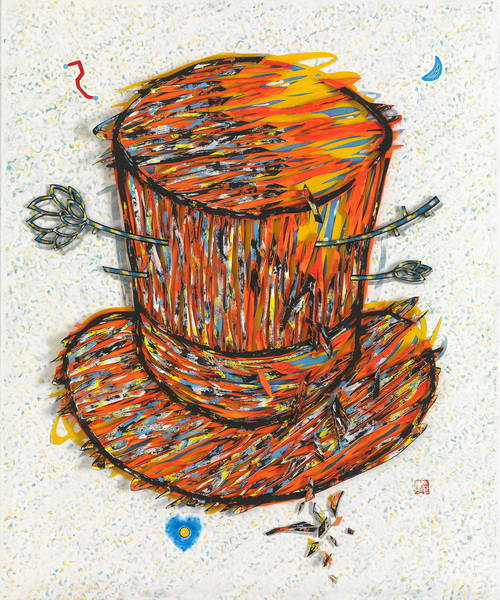
Jennis: When I ask artists what they want to express in their works, they often say that there is no answer because it depends on the viewer’s mind. Nevertheless, I would like to ask what you want to express through the hats and creatures that appear in your works.
Lee Doohwan: It is said that the inner mind has no form, but expressed in another way, having no form means that it may exist anywhere, or everywhere. So, I paint combined figures to represent people’s inner mind. My favorite motif is the magician’s hat, which hides a lot of things in it. Like the magician’s hat, people hide various inner thoughts within themselves. Magicians can retrieve the items from their hat at the right time, but most people cannot hide or reveal their thoughts and emotions freely like magicians. Our actions pop out like sneezes, unintentionally, unexpectedly. And sometimes, we cannot help revealing our hidden selves. I synthesize people’s inner minds into several images and express them in my paintings. I consider them to be the portraits of modern people.
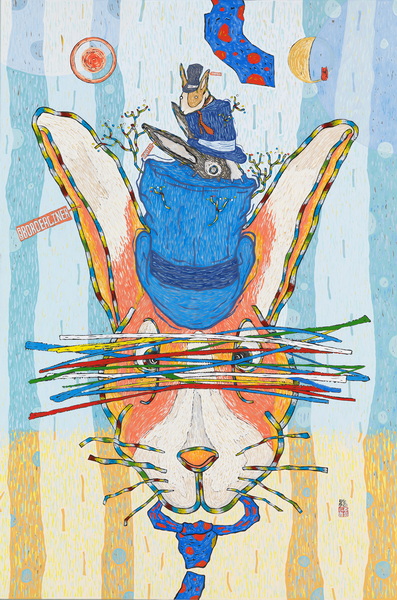
by Lee Doohwan, on jangji paper, 2019.
Jennis: So, you have been working on seeing yourself through other people. There is a work of yours called Boundary Man. What does that represent?
Lee Doohwan: I think I have always been on the boundary. Anyone can face a situation in which they have to make a choice but are undecided, that is, standing on the boundary between two possible choices. I express the situation in the form of rabbits. Rabbits are herbivores, but unexpectedly, they will eat meat, depending on the situation. Through images containing a twist of some type, I express the coexistence of contradictions.
Jennis: From listening to your story, your artworks seem to be talking to me. One more question: What does painting mean to you?
Lee Doohwan: Well, I think my painting is a process of finding myself while understanding others through observation. I hope my artworks are “read” by many viewers. I would be glad if the viewers took a pause to think about themselves for a moment.
Jennis: Thank you for making time for this interview. I am looking forward to seeing your artworks in many exhibition halls this year!
After the Interview…
Lee Doohwan’s works (bbojogi@hanmail.net) have been shown in over 200 exhibitions, including nine individual exhibitions. He has devoted himself to expressing the inner portraits of modern people in a traditionally Korean artistic manner. The motif of his paintings is not light; he paints in bright colors that draw viewers to his works to “read” them and to ponder.
The Interviewer
Kang Jennis Hyunsuk has been writing on local artists regularly for the Gwangju News for over a year. As a freelance interpreter and art lover, she loves to introduce the diverse sphere of Korean art to everyone who may have an interest. Instagram: @jenniskang





